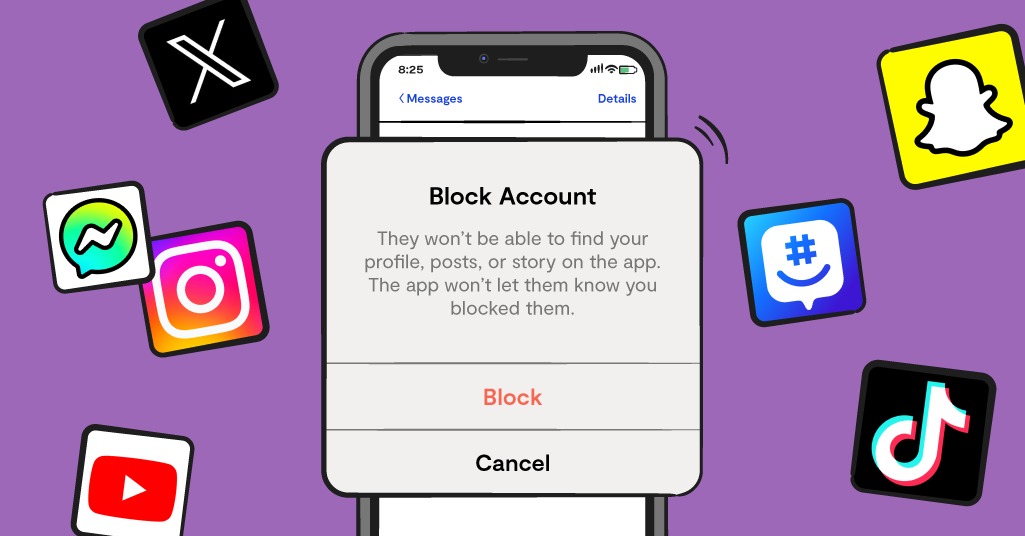At Bark, we’re pretty vocal about the inadequate parental controls and safety features social media platforms offer for families. However, one thing most social media platforms do have is the ability to block and report other users when they’re experiencing social media harassment.
Given they’re two of the tools kids have at their disposal against online harm, it’s crucial that kids know how and when to use them. But there are some key points that parents — and kids — need to know if their family ever faces a severe social media harassment situation. In this blog post, we’ll go over the good and bad of blocking and reporting tools, as well as steps on how to use them on popular social media platforms.
Blocking and Reporting on Social Media: Your First Line of Defense
A research report from Thorn surveyed how teens understand and interact with these online safety tools. They call blocking and reporting the “first line of defense” against social media bullying or harassment. If someone is harassing your child, the easiest way to nip it in the bud is to block them. Blocking should, in most cases, prevent the perpetrator from sending your child more messages. Next, reporting the user brings it to the platform’s attention, in hopes the perpetrator’s account will be taken down or receive some sort of reprimand.
Though blocking and reporting do not prevent harassment in the first place, they do put some level of control back into the victim’s hands to stop the messages. According to Thorn, teens are more likely to block — but not as likely to report — as it feels more “punitive.”
The Pitfalls of Blocking and Reporting
While these features are important, they still leave much to be desired in terms of a comprehensive solution for online safety. Perpetrators can easily find other ways to contact your child, either through different accounts or on different platforms. This can quickly turn into a game of whack-a-mole, continuously blocking bad actors when they pop up.
Another subtle downside of these features is that they may act as a deterrent for kids to seek help from trusted people in real life. Unfortunately, it’s common for kids to feel shame or fear punishment if they find themselves in a tricky situation online, so instead they try to handle it alone. They think if they just block the user, then that will solve it and they won’t need to tell anyone.
This is especially problematic if kids are the victim of an online predator and CSAM (child sexual abuse material) is involved. Kids may not only block the user, but they may delete messages with the predator, which can hurt legal efforts later down the line without that evidence. Kids need to know that their best option is to tell an adult who can effectively handle the situation.
Thorn also noted an interesting discrepancy between what teens think they’d do in these situations versus what they actually do. 40% of teens predicted they would turn to a trusted adult if they received a nude photo from an adult online — however, only 10% who experienced this actually did so. This speaks to the fact that these experiences can be so upsetting to kids that it makes it harder to make logical, safer decisions.
How to Block and Report on Popular Social Media Sites
As you can guess, the steps to block and report users are a little different on each platform. For your convenience, we’ve included below the steps for some of the most popular apps (and the most likely apps where kids experience bullying and/or severe sexual content, per Bark’s annual report). However, you can find steps for blocking and reporting on other social media platforms in our vast library of tech guides.
How to block and report on Instagram
- Tap the offending user’s username or profile photo. This will take you to their profile.
- Tap the “…” in the top right corner.
- Tap Block or Report.
How to block and report on Snapchat
- From any screen, tap on the chat bubble on the bottom navigation bar.
- Tap the magnifying glass icon to pull up a search window.
- Type in the offending user's name. Tap it when you see it.
- In the top left corner, click the profile picture.
- Next, tap the three dots in the top right corner.
- Tap Manage Friendship, then tap Block or Report.
How to block and report on Kik
- Tap the + button in the bottom right corner.
- Tap Find People.
- Search for the user you want to block or report, tap their name when it comes up.
- Tap the three dots in the top right corner.
- Tap Block or Report.
Let Bark Help Keep Your Child Safer on Social Media
Keeping tabs on your child’s social media activity can feel like a full-time job for already busy parents. That’s why so many families have found Bark’s monitoring tools to be a game-changer when it comes to online safety.
On 30+ social media platforms and apps, Bark scans your child’s activities, looking for concerning content such as bullying, sexual content, predation, and much more. If something is detected, an alert will be sent straight to your phone. No more stressing about finding time to search your child’s phone — Bark does the searching for you.
Along with monitoring, Bark can also help you block harmful social media apps, set screen time rules, track location, and more. Start your free, 7-day trial today.
Read more
Bark helps families manage and protect their children’s digital lives.






